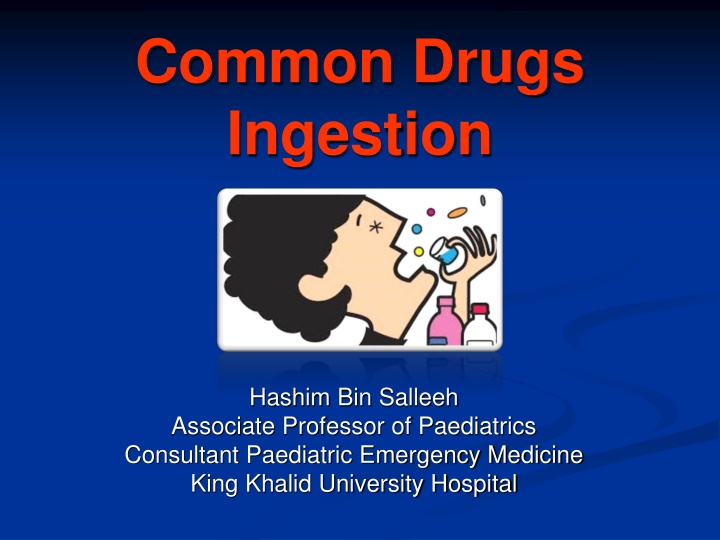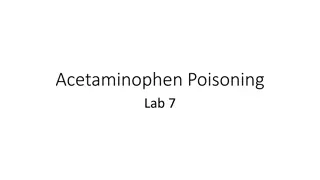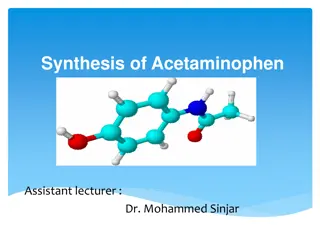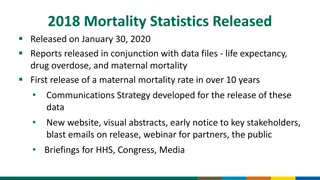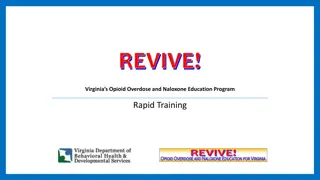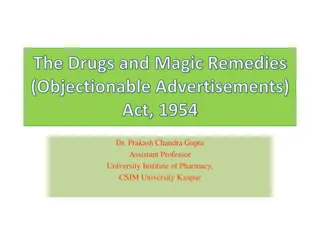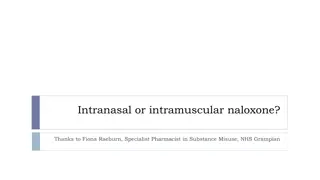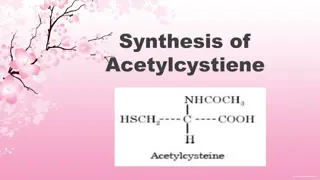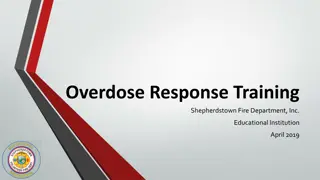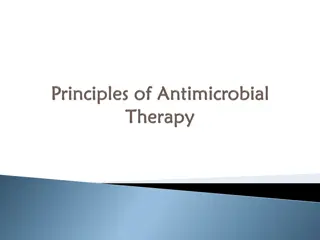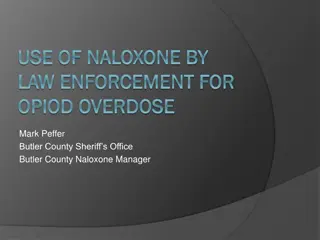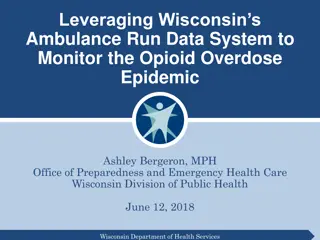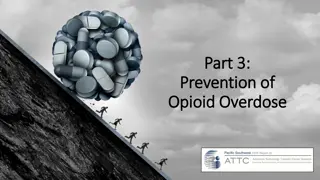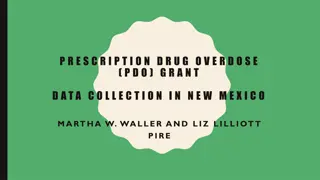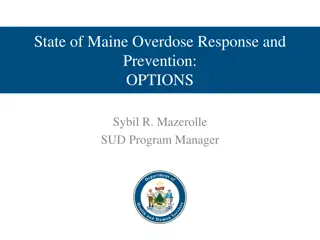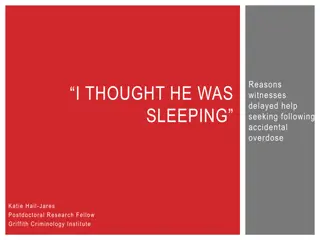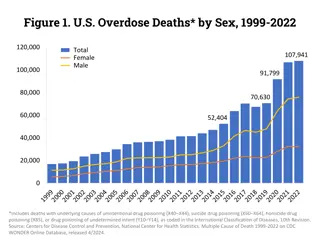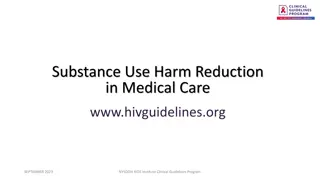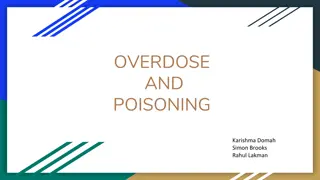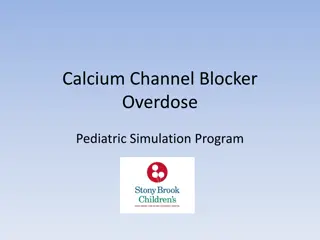Common Drugs Ingestion & Acetaminophen Overdose Overview
Acetaminophen (APAP) overdose is a serious issue with specific toxic doses based on age. Understand the pathophysiology, symptoms, and signs of APAP OD, along with indications for NAC therapy. Explore metabolic pathways involved in APAP metabolism and the consequences of overdose, including disruption of detoxification mechanisms leading to cellular dysfunction.
Download Presentation

Please find below an Image/Link to download the presentation.
The content on the website is provided AS IS for your information and personal use only. It may not be sold, licensed, or shared on other websites without obtaining consent from the author.If you encounter any issues during the download, it is possible that the publisher has removed the file from their server.
You are allowed to download the files provided on this website for personal or commercial use, subject to the condition that they are used lawfully. All files are the property of their respective owners.
The content on the website is provided AS IS for your information and personal use only. It may not be sold, licensed, or shared on other websites without obtaining consent from the author.
E N D
Presentation Transcript
Common Drugs Ingestion Hashim Bin Salleeh Associate Professor of Paediatrics Consultant Paediatric Emergency Medicine King Khalid University Hospital
Acetaminophen overdose N -acetyl-p-aminophenol (APAP)
Objectives By the end of this lecture, participants should be able to: Know the potential toxic dose of APAP according to age Understand the pathophysiology of APAP OD Know the symptoms and signs of APAP OD Know the indications of NAC therapy
APAP Acetaminophen has been approved for OTC use since 1960 1stcases of hepatic damage after APAP OD 1966 Therapeutic dose of acetaminophen is 10- 15 mg/kg/dose in children and 325-1000 mg/dose every 4-6 hours in adults, with a maximum of 4g/day
Toxic dose of APAP Children: < 12 months 150 mg/kg 1 6 y 200 mg/kg 1 6 y with risk factors 150 mg/kg 7 12 y 150 mg/kg Youth & Adult 7.5 - 10 g
Metabolic Pathways Hepatic glucuronide conjugation(40-65%) Hepatic sulfate conjugation(20-45%) inactive metabolites excreted in the urine. 90% Excretion of unchanged APAP in the urine (5%). Oxidation by P450 cytochromes (CYP 2E1, 1A2, and 3A4) to NAPQI(5-15%) GSH combines with NAPQI nontoxic cysteine/mercaptate conjugates excreted in urine.
Saturation of glucuronidation and sulfation pathways Amount of APAP metabolized by p450 cytochromes to NAPQI increases Normally NAPQI is detoxified by reduced GSH (glutathione) and thiol-containing substances In OD: rate and quantity of NAPQI formation overwhelms GSH supply and regeneration: elimination of NAPQI prolonged free NAPQI binds critical cell proteins with sulfhydryl groups cellular dysfunction and cell death. Animal models: hepatotoxicity when GSH stores fall <30% of baseline
Factors which adversely affect APAP metabolism Up regulation (i.e. induction) of CYP 2E1 enzyme activity Decreased glutathione stores Eating NAC Frequent dosing interval of APAP Prolonged duration of excessive dosing (Kuffner et al. 2001)
Clinical manifestation I 0.5-24h n/v, anorexia, asymptomatic II 24-48 h resolution of stage I sxs RUQ pain, elevation of PTT, INR, bili + enzymes (at the latest by 36h) III 48-96h coagulopathy, peaking of enzymes, acidosis, hypoglycemia, bleeding diathesis, jaundice, anuria, cerebral edema, coma. ARF in 25% of pts with hepatotoxicity IV 4-14d resolution
Diagnosis In the patient with a history of APAP overdose, a serum APAP level should be measured between 4 and 24 hours after ingestion The value obtained should be evaluated according to the Rumack-Matthew nomogram for determining the risk of hepatotoxicity and the need for NAC therapy
Toxicological History Often incomplete, unreliable or unobtainable Sources Patient, friends, family, EMS,or pill containers PMHx, liver/renal disease, concurrent medications, previous overdoses, P Hx, substance abuse
The 5Ws of toxicology Who pt s age, weight, relation to others What name and dose of medication, coingestants and amount ingested When time of ingestion, single vs. multiple ingestions Where route of ingestion, geographical location Why intentional vs. unintentional
Which lab test is the most sensitive for early detection of hepatotoxicity.? AST
Management Guidelines Airway Breathing Circulation Decontamination AC Find antidote NAC
NAC Early Prevents binding of NAPQI to hepatocytes GSH precursor increases GSH stores Increases sulfation metabolism of APAP less NAPQI formed Reduces NAPQI back to APAP (at least in animal models) Sulfur group of NAC binds and detoxifies NAPQI to cysteine and mercaptate conjugate (= GSH substitute)
NAC Late (12-24h) Modulates the inflammatory response Antioxidant, free radical scavenger Reservoir for thiol groups (i.e. GSH) Impairs WBC migration and function antiinflammatory Positive inotropic and vasodilating effects (NO) improves microcirculatory blood flow and O2 delivery to tissues Decreases cerebral edema formation, prevents progression of hepatic encephalopathy and improves survival
NAC NAC should optimally be given within 8 to 10 hours after ingestion More delayed therapy is associated with a progressive increase in hepatic toxicity some benefit may still be seen 24 hours or later after ingestion
What is the Rumack-Matthew nomogram?
Rumack-Matthew nomogram APAP level to predict which patients will develop an AST elevation >1000 IU/L with out antidotal treatment Derived from acute ingestion of immediate release acetaminophen Begins at 4 h post ingestion Recommended line of treatment has been lowered by 25% to increase its sensitivity
What percent of ptswhose APAP level falls above the upper line of the Rumack-Matthew normogram will develop hepatotoxicity? 60% (defined as elevation of the plasma transaminases above 1,000 U/L)
Indication for NAC APAP level above the treatment line Hx of significant APAP ingestion presenting close to 8h (give while waiting for level) All APAP ingestions who present late>24h with either detectable APAP or elevated transaminases Chronic ingestions (>4g/day in adult, >120mg/d in child) with elevated transaminases Hx of exposure and FHF
XR tablets Several studies show that elimination of extended and immediate-release acetaminophen are nearly identical after 4 hours. some case reports APAP levels falling above the treatment normogram line as late as 11-14 hours post ingestion of the extended-release preparation
15 month old child (wt. 10 kg) accidentally took full bottle of Tylenol 60cc(120mg/5cc) 30 min ago. Clinically looked well. What will be your treatment plan: a) Give Ipecac STAT b) Give 1g/kg activated charcoal Insert OGT and perform gastric lavage d) Should be observed for 4h then to do drug level e) None of the above c)
15 month old child accidentally took full bottle of Tylenol 60cc(120mg/5cc) 30 mint ago. Clinically looked well. What will be your treatment plan: a) Give Ipecac STAT b) Give 1g/kg activated charcoal Insert OGT and perform gastric lavage d) Should be observed for 4h then to do drug level e) None of the above c)
19 y old girl brought to ED with GCS 8 following drug ingestion (empty bottle of Tylenol was found in her room). What will be your first response a) 1g/kg activated charcoal STAT b) Orotracheal intubation Observation for 4 h d) Do CBC, CBG, PT, PTT, INR, Drug level e) NAC loading dose followed by infusion over 24 h c)
19 y old girl brought to ED with GCS 8 following drug ingestion (empty bottle of Tylenol was found in her room). What will be your first response a) 1g/kg activated charcoal STAT b) Orotracheal intubation Observation for 4 h d) Do CBC, CBG, PT, PTT, INR, Drug level e) NAC loading dose followed by infusion over 24 h c)
3 y old boy with accidental Tylenol ingestion on NAC for high drug level, after 48 h course LFT ,INR are high. What will be your recommendation: a) D/C NAC if drug level undetectable b) D/C NAC and repeat LFT, INR, drug level after 4h Continue on NAC until all his labs become normal d) D/C NAC, most likely it is secondary to concurrent viral illness c)
3 y old boy with accidental Tylenol ingestion on NAC for high drug level, after 48 h course LFT ,INR are high. What will be your recommendation: a) D/C NAC if drug level undetectable b) D/C NAC and repeat LFT, INR, drug level after 4h c) Continue on NAC until all his labs become normal d) D/C NAC, most likely it is secondary to concurrent viral illness
20 yr old pregnant girl ingested 20g of Tylenol in a suicidal gesture 36h ago. Her APAP is <10 and her AST is 90 How will you manage her medically? She asks you whether her baby will have any defects?
Common availability & routinely prescribed candy like appearance Chronic overdose Multiple blood transfusions Thalasemia Oncology patients Acute overdose: Iron Preparations Elemental Fe (%) Contents Ferrous chloride Ferrous fumarate Ferrous gluconate 28 33 12 Ferrous lactate 19 Ferrous sulfate 20
Pathophysiology @ Therapeutic /daily requirement: absorption of iron is normally very tightly controlled by the GI system @ overdose: Iron exerts both local and systemic effects Corrosive to the GIT (bleeding, perforation, peritonitis) local damage to the GI mucosa allows unregulated absorption, which leads to potentially toxic serum levels Excess free iron is a mitochondrial toxin that leads to derangements in energy metabolism Metabolic acidosis and its effect on multiple organ (heart, lungs, and liver)
Management Toxicological History Unintentional Timing is important Number of pills Formulation e.g. a 10-kg child who consumed 10 tablets of 320 mg ferrous gluconate (12% elemental iron per tablet), 10 tablets 38.4 mg elemental iron per tablet = 384 mg/10 kg = 38.4 mg/kg Physical Examination 5 phases Patients may not always demonstrate each of the phases.
Management Serum iron levels peak 4-6 hours post ingestion peak level predicts severity Iron is rapidly cleared from serum and deposited in the liver A measured level after the peak can be deceptively low Serum iron levels generally correlate with clinical severity TIBC, glucose, and WBC counts are unreliable in predicting toxicity Abdominal X-ray can be used to confirm ingestion
Management Airway Breathing Circulation Fluid Decontamination No charcoal No gastric lavage WBI Elimination None Finding Antidote Deferoxamine
Management Deferoxamine Chelates free iron in the plasma resulting in water soluble complexes that can be renally excreted Fe level > 500 mcg/dl Presence of metabolic acidosis Lethargy/coma Shock Toxic appearance
SALICYLATES OVERDOSE Found in hundreds of OTC medications important cause of morbidity and mortality Antipyretic, antiplatelet, and an anti-inflammatory agent Formulation Tabs Baby Aspirin 80mg Adult Aspirin 325mg Topical Oil of wintergreen Pepto-Bismol toxicity more & severe elderly infants
Range of toxicity >150 mg/kg no toxicity- mild toxicity 150-300 mg/kg Mild-Moderate toxicity 301-500 mg/kg Serious toxicity <500 mg/kg lethal toxicity Large amount of salicylate Saturates the body s protein-binding capacity Leaves free salicylate in the serum
